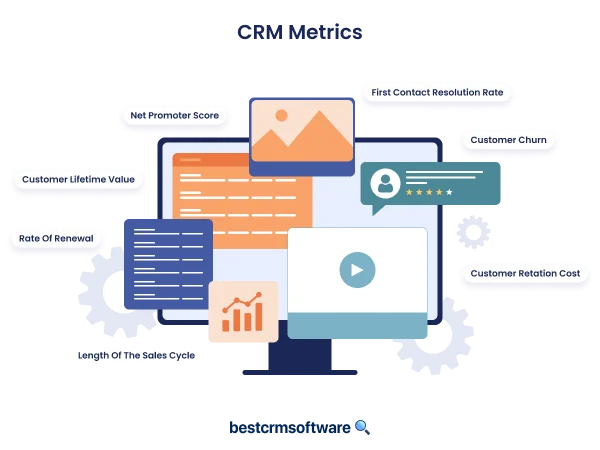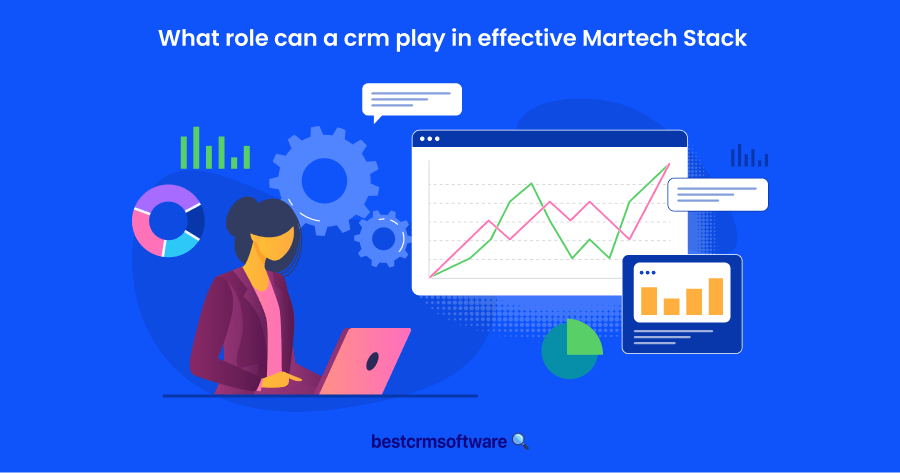
CRM Metrics
Key Takeaways
The benefits we found to using CRM systems:
- Analyze the overall impact of your customer support, sales, and marketing efforts
- Determine high-priced prospects and concentrate on the most lucrative clients
- Forecast future revenue based on the lead value and conversion rate
- Improve client retention and lower attrition by offering excellent support and service
- Gain more insight into the preferences and needs of your customers to increase loyalty and satisfaction
- Determine which phases of the sales funnel require further attention and development to optimize it
- Track staff performance and provide coaching and feedback to develop their abilities
In a Nutshell
CRM metrics refer to software or systems that have revolutionized how companies handle consumer engagement. CRM tools and features give insights into each customer’s unique journey and transform incoherent touchpoints into usable data.
These metrics are the key data points that demonstrate how well your customer service, sales, and marketing campaigns generate and close deals, keep customers and boost income.
So how do you know which CRM Metric best suits your business? We’ve taken an in-depth look at CRM Metrics, how they can enhance your revenue and drive growth to your business, and why they are important to your business.
How Can CRM Metrics Enhance Your Revenue?
CRM provides several advantages and benefits to a business by collecting and organizing customer interaction data, making it available and useful for everyone, and simplifying the analysis of that data. These aspects of the customer journey including client acquisition, retention, happiness, and overall engagement are key components to business growth.
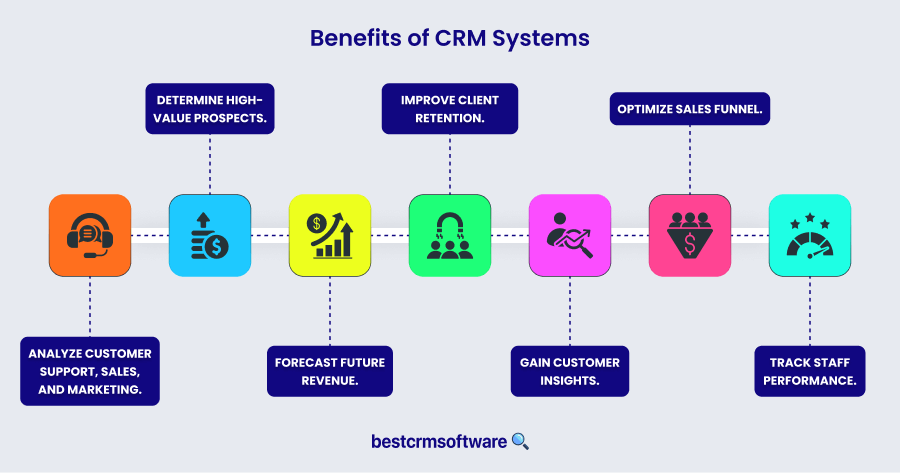
Recommendation Selling
Suggestion selling is a sales strategy that is frequently used when a business suggests to its customers additional, excellent goods or services to complement those they have already subscribed to or bought.
With good CRM software, you can tailor it to suit your customer’s suggestions. You can also set it to collect important data about your customers by using thoughtful questions.
For instance, if you run a grocery store, you can ask the following questions of your customers:
- What are your favorite vegetables?
- Do you like dried fruit?
- Do you want home delivery?
In such an approach, customers will feel that their personal preferences are important to you and it doesn’t sound like a sales pitch. This now allows you to do suggestion selling which is bound to translate to sales.
Access to Centralized Information About your Customers
CRM systems allow businesses to communicate with customers in a meaningful way regularly and at the best possible times. In general, this means you can increase favorable company productivity, product management, bottom-line sales, and revenue results. They also encourage improved staff cooperation.
CRM solutions are essentially made to take up residence in the information hub of every business, serving as the knowledge roadmap and profitability engine for each client-focused, revenue-driven organization in existence.
Effective Customization for Customers Needs and Tastes
For every lead prospect, new customer, and repeat customer, a CRM system saves detailed information, making it possible to create personalized sales and marketing communications.
Client follow-ups are completed quickly and efficiently with an automated smart CRM system, freeing up time for more productive management, marketing, and sales tasks. The sales funnel process guarantees that every client and stage of the successful startup journey receives personalized, targeted attention.
Better Understanding of the Sales Funnel
With a good CRM, sales managers have access to accurate data on the success of individual team members in reaching their sales goals, as well as the performance of specific sales teams, goods, and campaigns.
The sales representatives enjoy reduced administrative work, have a better comprehension of their clientele, and have the chance to spend more time selling rather than entering data.
Making Communication Easier Between Employees
Using a CRM system helps your team maintain a consistent brand voice by making it simple to observe how other staff members are interacting with potential customers. Within a single system, team members may also tag each other on projects, exchange emails and messages, and send notes or alerts to one another.
Increased Revenue
CRM may help you generate more income by enhancing customer awareness, engagement, and operational efficiency. Increased sales may result from happy customers being more likely to return for further purchases and to recommend your company to others.
You may boost the possibility that clients will make more purchases by offering tailored recommendations, too.
To sum up, CRM implementation is crucial for every corporate company that hopes to grow its clientele and boost earnings. CRM may support long-term success by enhancing customer understanding, engagement, and operational efficiency.
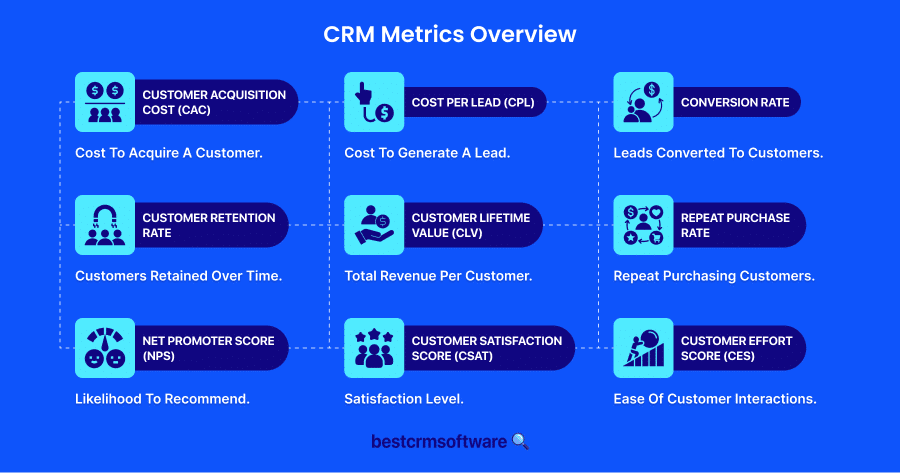
Which CRM Metrics are Important?
There is that old saying: “If you can’t measure it, you can’t improve it.”
As CRM experts, we know that to accelerate growth you must continually measure performance and work on improvement. When chosen and monitored appropriately, CRM metrics highlight the strengths and shortcomings of a particular customer relationship.
To know which CRM metrics to focus on, we are going to show you how to develop SMART goals for your business.
SMART stands for:
- Specific: What’s the goal you want to achieve? eg. “We want to have 10 new subscribers by the end of the year.”
- Measurable: What unit are you using to track progress? The goal should be quantifiable to be able to track progress and know when you get to the finish line.
- Achievable: Is your goal realistic? Do we have enough resources and capabilities to achieve it?
- Relevant: Why is this goal important? How will it help you expand your business?
- Time-Bound: By what time do you want to achieve our goal? Is it in three months, six months, or by the end of the year?
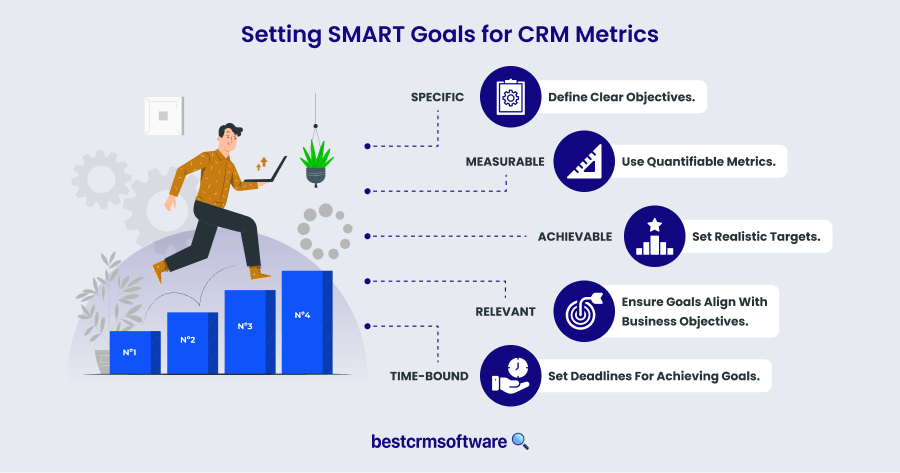
This approach to goal-setting for your client relationships provides your objectives greater meaning and will eventually increase your chances of achieving them.
Next, we’ll go over important CRM metrics that, by showing your marketing and sales staff where they need to make adjustments and how well they’re doing, may make their jobs simpler.
Here are the metrics that your team should be tracking:
Customer Acquisition Metrics
The goal of every sales and marketing team is to acquire as many customers as possible for the least amount of money. The cost of client acquisition provides insight into how well you’re accomplishing your goal.
- Customer Acquisition Cost (CAC)
This metric measures the amount an organization spends to acquire new customers. To calculate you divide the entire amount spent on customer acquisition by the total number of clients you acquire to get the CAC.
- Cost Per Lead (CPL)
With this digital marketing price model, the advertiser pays a predetermined sum for each lead they produce. CPL is the surest way to gain loyal customers who may become repeat customers and also they may recommend you to customers with similar interests.
When a customer clicks on an advertisement he is sent to the business website where he is asked to opt-in to the active campaign. It could be a discount or an available sale for a specified period. If he goes ahead to click, it means a lead has been generated and the publisher will be compensated as per the set “cost per lead.”
- Conversion Rate
This rate shows the percentage of people who completed a desired task. After advertising with clicks, we can easily determine the conversion rate of the advert. To calculate we take the total number of users who clicked dividing it by the total size of the audience, then multiply the result by 100 to get a percentage.
Conversion rates help in comparing the performance of different campaigns and can be used as a measure of ROI for upcoming campaigns.
Customer Retention Metrics
We should emphasize that retaining a customer is more important than acquiring a new one.
According to the Pareto Principle, 80% of your results come from 20% of your already existing customers.
Your customer retention rate refers to the number of customers you retain over some time and it should be high.
- Customer Churn Rate
This refers to the number of customers that stop doing business with you in a given period. Every business goes through this but a low churn rate is best for business to thrive. The CRM metric may not elaborate why it is happening but it will give you pointers that may help you to solve the problem.
- Customer Lifetime Value
This metric refers to the total amount of revenue a business can expect from a single customer within the time you do business with them. It’s a simple measurement of a customer’s value to the business.
Tracking CLV helps a business to come up with strategies for maintaining existing customers and acquiring new ones.
- Repeat Purchase Rate
This metric measures the percentage of customers who make a purchase and later return to make another purchase. It can be calculated using different time frames and all you do is divide the number of return orders by the number of total customers, and then multiply by 100. The rate is expressed as a percentage.
Customer Satisfaction Merits
A satisfied customer base is important as it means customers love what you are offering. Customer satisfaction boosts customer loyalty and trust consequently growing your sales and audience.
- Net Promoter Score (NPS)
NPS is used to measure customers’ experience. It’s calculated by asking customers one single-question survey: “How likely are you to recommend this product or service to a colleague or friend?” The answers are classified as promoters, passives, and detractors.
To calculate NPS, you minus the percentage of detractors from the percentage of promoters.
- Customer Satisfaction Score (CSAT)
This score measures to what level customers are satisfied with your goods or services on a scale. It is measured through the feedback of customers and expressed as a percentage.
- Customer Effort Score (CES)
This metric is based on a customer satisfaction survey measuring how easy it is for people to use a product or service. It measures how much effort consumers use to acquire your goods or receive your services. A low CES is considered ideal for your business.
How to Drive Growth Using the Right Metrics
Driving growth using the right metrics involves first defining your business objectives and goals. Once your goals are clear, you then identify the metrics that are specific to your goals. The metrics should be SMART and then collect important data to track these metrics.
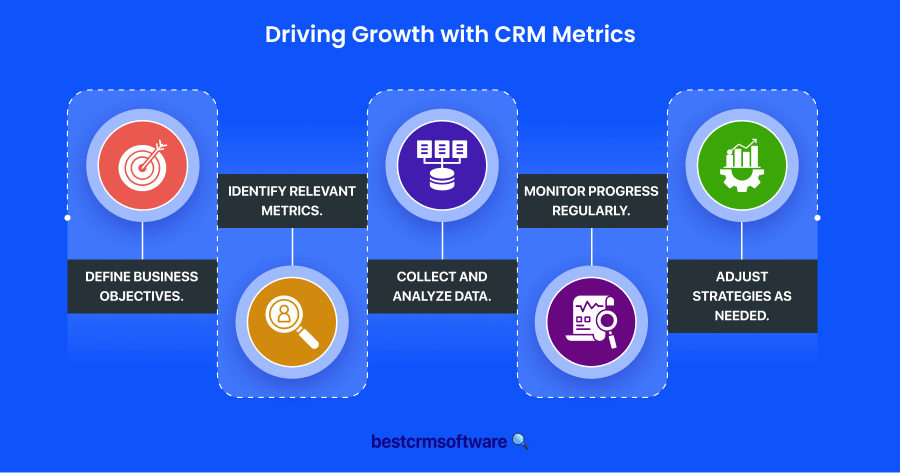
It also requires regular monitoring and review of the success metrics to keep tabs on your business progress and adjust accordingly.
CRM Metric to Drive Growth
We can’t emphasize enough the importance of businesses including CRM Metrics in their plan because you’ll gain a comprehensive view of your company’s performance. And if you’re on pace to meet your SMART objectives by monitoring any or all of the CRM indicators we’ve included, the usefulness of the metrics you decide to monitor will depend on the quality of the supporting data.
Check out our other blogs too! Our CRM experts publish helpful content daily, covering everything from how-to guides to blogs on the best project management CRMs.


